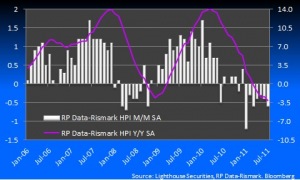Australian Data
The domestic data calendar was dominated by deteriorating data from the non-mining sector with new home sales and house prices falling along with private sector building approvals and weak credit figures while an increase in retail sales wasn’t enough to stop the annual trend rate dropping to the lowest on record. Private capex figures, however, showed that the investment boom driven by the mining sector continues unabated, providing a buffer against the weakness in the rest of the economy.
New Home Sales
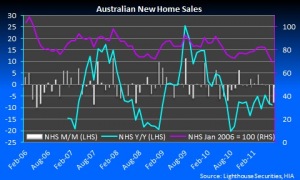 New home sales were nothing short of terrible, falling 8% in July after an 8.7% fall in June which has taken the index of new home sales to below the levels reached during the GFC. According to the HIA-JELD-WEN report detached house sales fell by 9 per cent in the month of July 2011 while sales of multi-units increased by 1 per cent. By state detached new house sales fell by 11.2 per cent in New South Wales, 7.8 per cent in Victoria, 8.5 per cent in Queensland, 1.5 per cent in South Australia, and 12.7 per cent in Western Australia.
New home sales were nothing short of terrible, falling 8% in July after an 8.7% fall in June which has taken the index of new home sales to below the levels reached during the GFC. According to the HIA-JELD-WEN report detached house sales fell by 9 per cent in the month of July 2011 while sales of multi-units increased by 1 per cent. By state detached new house sales fell by 11.2 per cent in New South Wales, 7.8 per cent in Victoria, 8.5 per cent in Queensland, 1.5 per cent in South Australia, and 12.7 per cent in Western Australia. Building Approvals
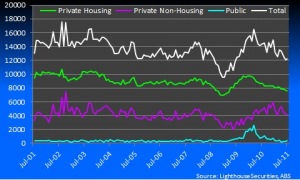 Building Approvals managed a small gain of 1% In July, short of the 2% rise that the market was expecting however approvals remain 15% below the same time last year. The marginal increase actually masked underlying weakness in the series as the gains were entirely driven by a 77% increase in public sector approvals. Private sector approvals were down 0.6% with private housing approvals falling 0.2%, remaining in a clear downtrend while private non-housing or medium density approvals were down 1.4%
Building Approvals managed a small gain of 1% In July, short of the 2% rise that the market was expecting however approvals remain 15% below the same time last year. The marginal increase actually masked underlying weakness in the series as the gains were entirely driven by a 77% increase in public sector approvals. Private sector approvals were down 0.6% with private housing approvals falling 0.2%, remaining in a clear downtrend while private non-housing or medium density approvals were down 1.4%
RP Data-Rismark House Price Index
The RP Data Rismark house price index showed prices on a seasonally adjusted basis fell for the seventh straight month in July. Prices are now down 3.2% over the past 12 months and are off 3.7% from their peak in December 2010. Most capital cities experienced falls over the month with Melbourne (-1.4%), Perth (-1.1%), Adelaide (-1.1%) and Brisbane (-0.4%) all suffering declines while Sydney (+0.1) and Canberra (+1.9%) bucked the trend. The pace of price declines at a national level is currently faster than the falls experienced during 2008.
RBA Private Sector Credit
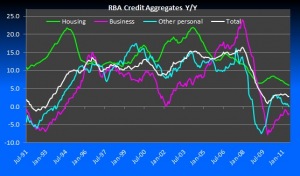 The RBA’s private sector credit aggregates showed the total outstanding debt only rose 0.2% over the month with business credit flat and personal credit continuing to fall, dropping 0.3% over the month. Housing credit was the only component to post a rise, increasing 0.4%, however the annual rate of growth slowed further to 5.9%, its slowest pace since the series began in 1976 as appetite for borrowing remains subdued and households continue to pay down outstanding debt quicker than has historically been the case.
The RBA’s private sector credit aggregates showed the total outstanding debt only rose 0.2% over the month with business credit flat and personal credit continuing to fall, dropping 0.3% over the month. Housing credit was the only component to post a rise, increasing 0.4%, however the annual rate of growth slowed further to 5.9%, its slowest pace since the series began in 1976 as appetite for borrowing remains subdued and households continue to pay down outstanding debt quicker than has historically been the case.
Retail Sales
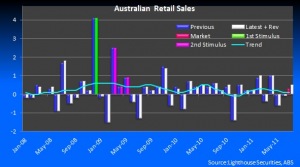 Retail sales for July beat estimates, rising 0.5% against expectations of a 0.3% rise however excluding the 0.8% rise in food sales, total retail sales were only up 0.3% and on an annual basis were actually down 0.5%. Of the other components, Household goods were flat, Department stores were up 1.2%, Cafés and restaurants were up 1.1%, Other up 1.9% while Clothing sales fell 4.2%. Most importantly, the monthly trend rate of growth remained unchanged at 0.1% while the annual change in trend sales fell to its lowest level since the series began
Retail sales for July beat estimates, rising 0.5% against expectations of a 0.3% rise however excluding the 0.8% rise in food sales, total retail sales were only up 0.3% and on an annual basis were actually down 0.5%. Of the other components, Household goods were flat, Department stores were up 1.2%, Cafés and restaurants were up 1.1%, Other up 1.9% while Clothing sales fell 4.2%. Most importantly, the monthly trend rate of growth remained unchanged at 0.1% while the annual change in trend sales fell to its lowest level since the series began
Q2 Capital Expenditure
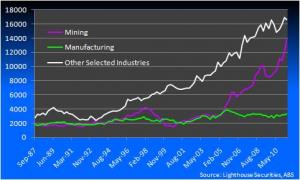 Total Private Capital Expenditure rose a solid 4.9% in real terms in Q2 to be up 23.3% over the year while the first quarters rise of 3.4% was revised up to a robust increase of 7.7%. Investment from the mining industry continues to dominate the investment landscape with their capex up 14.4% over the quarter alone which accounted for the bulk of the total gain with mining capex up 47.1% over the year. Manufacturing capex was up 3.7% over the quarter however activity in the manufacturing sector continues to contract according to the AIG manufacturing PMI
Total Private Capital Expenditure rose a solid 4.9% in real terms in Q2 to be up 23.3% over the year while the first quarters rise of 3.4% was revised up to a robust increase of 7.7%. Investment from the mining industry continues to dominate the investment landscape with their capex up 14.4% over the quarter alone which accounted for the bulk of the total gain with mining capex up 47.1% over the year. Manufacturing capex was up 3.7% over the quarter however activity in the manufacturing sector continues to contract according to the AIG manufacturing PMI
Offshore Data
The offshore data was unfortunately weak once again this week and while some of the economic indicators in the US held up a little better than the market had been expecting, last night’s US non farm payrolls release confirmed the extent of the slowdown in August with employment growth stagnating over the month. While the US may not officially be in a recession yet, it is certainly teetering on the edge of one.
US Consumer Spending and Income
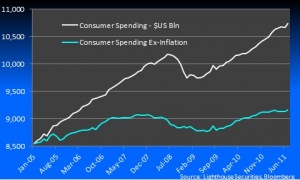 After showing signs of stalling in recent months, consumer spending jumped 0.8% in July which was more than twice analyst estimates with the jump reportedly drive by an increase in auto sales. Inflation adjusted however the increase was a far more subdued 0.3% but a rise nonetheless. Personal income rose 0.3% over the month with real wages continuing to go backwards and are now down 1% from a year ago. It will be interesting to see if the increase in consumer spending can hold during august after a sharp fall in consumer confidence already in August.
After showing signs of stalling in recent months, consumer spending jumped 0.8% in July which was more than twice analyst estimates with the jump reportedly drive by an increase in auto sales. Inflation adjusted however the increase was a far more subdued 0.3% but a rise nonetheless. Personal income rose 0.3% over the month with real wages continuing to go backwards and are now down 1% from a year ago. It will be interesting to see if the increase in consumer spending can hold during august after a sharp fall in consumer confidence already in August.
US Pending Home Sales
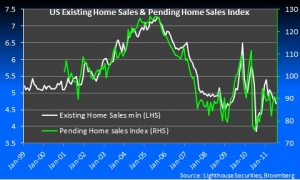 The woes of the US housing market continue with pending home sales sliding 1.3% in July which was worse than the markets expectations of a 1% decline. There were quite divergent outcomes across the different regions with pending sales in the Midwest (-0.8%), Northeast (-2.0%) and the South (-4.8%) all declining while pending sales in the West jumped by 3.8% over the month and continue to outperform.
The woes of the US housing market continue with pending home sales sliding 1.3% in July which was worse than the markets expectations of a 1% decline. There were quite divergent outcomes across the different regions with pending sales in the Midwest (-0.8%), Northeast (-2.0%) and the South (-4.8%) all declining while pending sales in the West jumped by 3.8% over the month and continue to outperform.
US Dallas Federal Reserve Manufacturing Survey
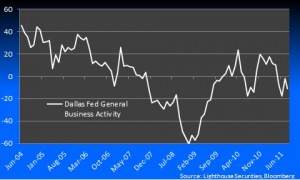 The Dallas Fed manufacturing survey General Business Activity index followed its regional counterparts lower in August with the index falling more than expected from -2 to -11.4. It has now been negative for 3 of the past four months and according to the report from the Dallas Fed “Expectations regarding future business conditions were generally less optimistic in August. The index of future general business activity edged down as did most indexes of future manufacturing activity”.
The Dallas Fed manufacturing survey General Business Activity index followed its regional counterparts lower in August with the index falling more than expected from -2 to -11.4. It has now been negative for 3 of the past four months and according to the report from the Dallas Fed “Expectations regarding future business conditions were generally less optimistic in August. The index of future general business activity edged down as did most indexes of future manufacturing activity”.
US S&P-CaseShiller House Price Index
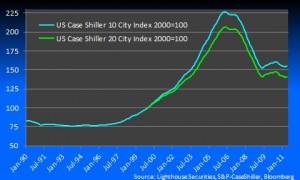 House prices according to the S&P-CaseShiller house price index were largely unchanged on a seasonally adjusted basis with the 10 city index positing a gain of 0.04% in June while the 20 city index fell by 0.06%. The pace of house price declines clearly slowed in May and June with the market showing tentative signs that it may be finally be forming a bottom. However this isn’t the first time it has looked like forming a bottom on to fall to new lows a few months later. With confidence slumping in August and the outlook for the US and global economy deteriorating substantially since June, we wouldn’t be calling a bottom just yet.
House prices according to the S&P-CaseShiller house price index were largely unchanged on a seasonally adjusted basis with the 10 city index positing a gain of 0.04% in June while the 20 city index fell by 0.06%. The pace of house price declines clearly slowed in May and June with the market showing tentative signs that it may be finally be forming a bottom. However this isn’t the first time it has looked like forming a bottom on to fall to new lows a few months later. With confidence slumping in August and the outlook for the US and global economy deteriorating substantially since June, we wouldn’t be calling a bottom just yet.
US Conference Board’s Consumer Sentiment survey
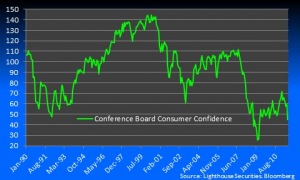 The Conference Board’s consumer sentiment index followed the University of Michigan index which was released earlier this month, falling heavily in August. The index slumped from 59.2 to 44.5, which was well below the 52 that was expected. The Present Situation index slid from an already weak 35.7 to 33.3 while the Expectations index tumbled from 74.9 to 51.9 which is its lowest level since the GFC. However the latest read of the overall index is the 6th lowest on record going back to 1967 with the other 5 occurring during the depths of the GFC
The Conference Board’s consumer sentiment index followed the University of Michigan index which was released earlier this month, falling heavily in August. The index slumped from 59.2 to 44.5, which was well below the 52 that was expected. The Present Situation index slid from an already weak 35.7 to 33.3 while the Expectations index tumbled from 74.9 to 51.9 which is its lowest level since the GFC. However the latest read of the overall index is the 6th lowest on record going back to 1967 with the other 5 occurring during the depths of the GFC
US Chicago PMI
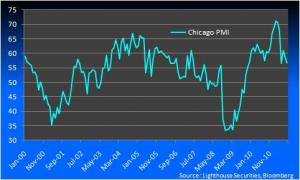 After some shocking manufacturing indicators so far for August, the Chicago PMI provided a positive surprise, beating expectation after it only slid to 56.5 in August from 58.8 a month earlier after it was expected to drop to 53.3. The production index fell heavily from 64.3 to 57.8 however new orders held up a little better, falling to 56.9 from 59.4 while the employment index actually rose, climbing to 52.1 from 51.5.
After some shocking manufacturing indicators so far for August, the Chicago PMI provided a positive surprise, beating expectation after it only slid to 56.5 in August from 58.8 a month earlier after it was expected to drop to 53.3. The production index fell heavily from 64.3 to 57.8 however new orders held up a little better, falling to 56.9 from 59.4 while the employment index actually rose, climbing to 52.1 from 51.5.
US Factory Orders
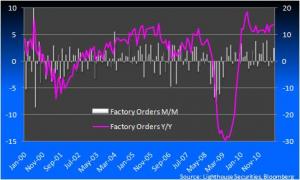 US Factory orders also surprised on the upside, rising 2.4% in July against expectations of a 2% gain while the previous months decline of 0.8% was revised up to show a fall of 0.4%. However orders ex-transportation were only up 0.9% while capital goods orders rose 1.9% after a 2.4% last month. After falling 31% during the GFC, factory orders have since risen 35% to be 6.5% below their pre-crisis peak.
US Factory orders also surprised on the upside, rising 2.4% in July against expectations of a 2% gain while the previous months decline of 0.8% was revised up to show a fall of 0.4%. However orders ex-transportation were only up 0.9% while capital goods orders rose 1.9% after a 2.4% last month. After falling 31% during the GFC, factory orders have since risen 35% to be 6.5% below their pre-crisis peak.
US ISM Manufacturing Index
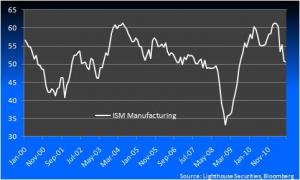 The US ISM manufacturing index also performed better than expected after it slid from 50.9 to 50.6 in August indicating the manufacturing still expanded, albeit at a very slow rate. The releases eased fears that the US is already in a recession after the index was expected to fall below 50 to 48.5 after the majority of regional Fed surveys indicated a sharp pull back in activity over the past month
The US ISM manufacturing index also performed better than expected after it slid from 50.9 to 50.6 in August indicating the manufacturing still expanded, albeit at a very slow rate. The releases eased fears that the US is already in a recession after the index was expected to fall below 50 to 48.5 after the majority of regional Fed surveys indicated a sharp pull back in activity over the past month
US Nonfarm Payrolls Report
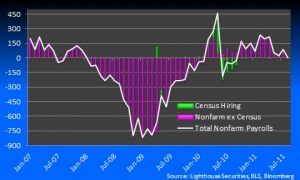 The latest nonfarm payrolls report confirmed the extent of the slowdown in the US economy during August with total employment unchanged according to the establishment survey while the previous months gain of 117k was revised down to an increase of 85k. Private payrolls were up 17k indicating that the public sector continues to shed jobs. Despite the weak jobs growth the unemployment rate remained unchanged at 9.1% after total employment rose 331k according to the more volatile household survey, just keeping up with the growth in the labour force after it increased by 366k.
The latest nonfarm payrolls report confirmed the extent of the slowdown in the US economy during August with total employment unchanged according to the establishment survey while the previous months gain of 117k was revised down to an increase of 85k. Private payrolls were up 17k indicating that the public sector continues to shed jobs. Despite the weak jobs growth the unemployment rate remained unchanged at 9.1% after total employment rose 331k according to the more volatile household survey, just keeping up with the growth in the labour force after it increased by 366k.
